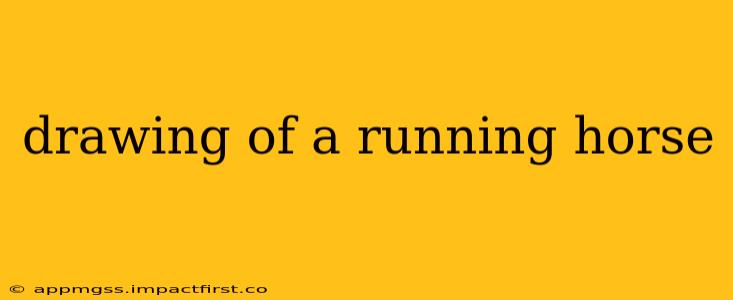How to Draw a Running Horse: A Step-by-Step Guide for Beginners and Beyond
Drawing a running horse can seem daunting, but with the right approach, it's achievable even for beginners. This guide breaks down the process into manageable steps, covering everything from basic shapes to adding dynamic details. Whether you're a seasoned artist or just starting out, you'll find valuable techniques and tips to improve your horse drawings.
Understanding Horse Anatomy for Dynamic Poses
Before you start sketching, understanding the basic anatomy of a horse is crucial for capturing its movement realistically. Observe the powerful muscles, the graceful curves of its neck and body, and the elegant structure of its legs. Study images of running horses to familiarize yourself with how their limbs move in coordination. Pay close attention to the angle of the legs and how the body stretches and flexes during a run. Knowing these aspects will greatly enhance your drawing's accuracy and dynamism.
Step-by-Step Guide to Drawing a Running Horse
Step 1: Basic Shapes: Begin by sketching simple shapes to represent the horse's body. Think of an elongated oval for the body, a circle for the chest, and smaller ovals for the head and legs. These initial shapes will serve as the foundation for your drawing, allowing you to establish the horse's overall posture and movement.
Step 2: Refining the Form: Refine the initial shapes, gradually transforming them into the horse's body. Add curves to the oval representing the body, giving it a more natural, flowing form. Pay attention to the muscles, subtly indicating their bulk and definition through subtle shading and line variations.
Step 3: Legs and Hooves: Carefully draw the legs, keeping in mind the anatomical structure and the angle of the legs during the run. Each leg should be positioned dynamically, reflecting the horse's motion. Add the hooves, ensuring they are proportionate to the rest of the legs and touch the ground in a realistic manner.
Step 4: Head and Neck: Sketch the horse's head and neck, paying attention to the graceful curve of the neck and the expressive details of the head. Add the ears, eyes, nostrils, and mouth, capturing the horse's personality through subtle nuances in the features.
Step 5: Tail and Mane: Add the tail and mane, emphasizing their movement. The flowing mane and tail should complement the horse's running posture, adding to the dynamism of the drawing. Don't be afraid to use flowing, expressive lines to create a sense of motion.
Step 6: Refining Details and Shading: Once you've established the basic form, focus on refining the details. Add more muscle definition, refine the proportions, and enhance the overall realism. Use shading to give the horse volume and depth, emphasizing the areas where light and shadow interact. Pay attention to the light source and how it affects the horse's form.
What are the different styles of drawing a running horse?
There are many styles, from realistic depictions focusing on anatomical accuracy to more stylized or cartoonish representations. Realistic styles emphasize accurate musculature and movement, while stylized versions might prioritize artistic expression over perfect anatomical detail. Cartoon styles are often simplified and exaggerated for comedic effect. The choice of style depends entirely on your artistic goals and preferences.
How can I make my running horse drawing look more dynamic?
To add dynamism, focus on the horse's posture and the flow of its lines. Exaggerate the curvature of the body, emphasizing the stretch and flexion of muscles. Use dynamic lines, implying speed and energy. Consider adding motion blur to the mane and tail, further enhancing the sense of movement.
What materials are best for drawing a running horse?
The best materials depend on your preferred style and skill level. Pencils (ranging in hardness) are excellent for sketching and shading. Charcoal provides rich dark tones, ideal for creating depth and texture. Markers and pens can create bold lines and vibrant colors in stylized drawings. Experiment to discover what works best for you.
This comprehensive guide equips you with the knowledge and techniques to draw a running horse. Remember, practice is key! The more you draw, the better you'll become at capturing the grace and power of these majestic animals.
